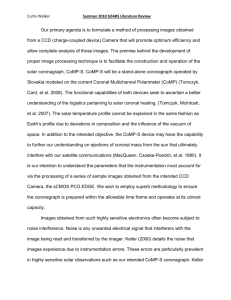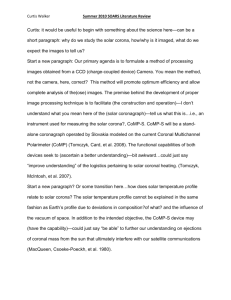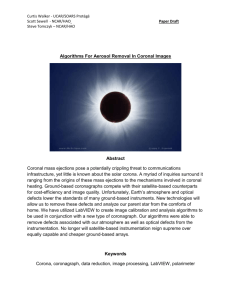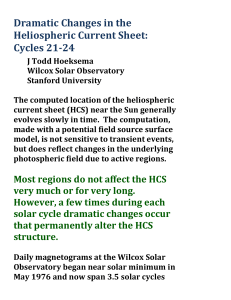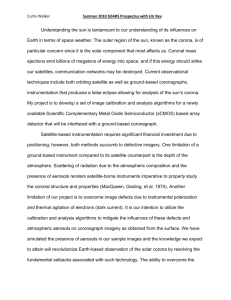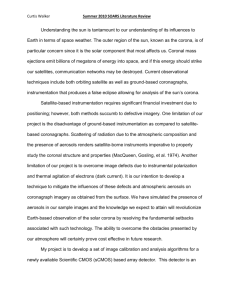CW - Paper - Draft 1.2
advertisement
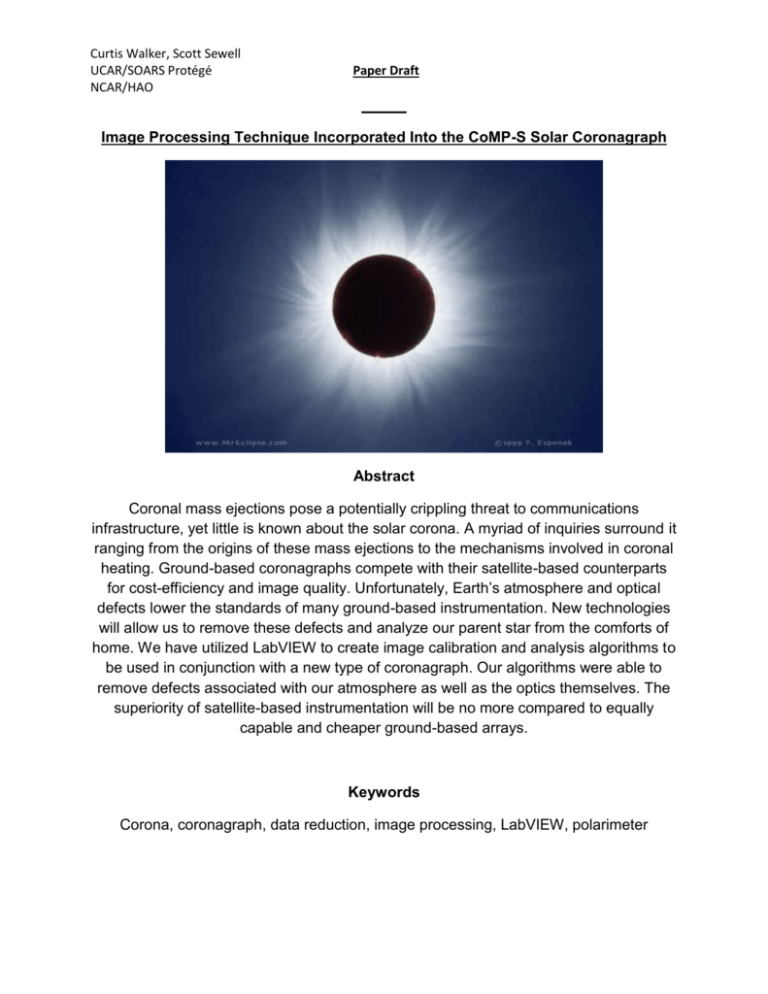
Curtis Walker, Scott Sewell UCAR/SOARS Protégé NCAR/HAO Paper Draft Image Processing Technique Incorporated Into the CoMP-S Solar Coronagraph Abstract Coronal mass ejections pose a potentially crippling threat to communications infrastructure, yet little is known about the solar corona. A myriad of inquiries surround it ranging from the origins of these mass ejections to the mechanisms involved in coronal heating. Ground-based coronagraphs compete with their satellite-based counterparts for cost-efficiency and image quality. Unfortunately, Earth’s atmosphere and optical defects lower the standards of many ground-based instrumentation. New technologies will allow us to remove these defects and analyze our parent star from the comforts of home. We have utilized LabVIEW to create image calibration and analysis algorithms to be used in conjunction with a new type of coronagraph. Our algorithms were able to remove defects associated with our atmosphere as well as the optics themselves. The superiority of satellite-based instrumentation will be no more compared to equally capable and cheaper ground-based arrays. Keywords Corona, coronagraph, data reduction, image processing, LabVIEW, polarimeter Curtis Walker Paper DRAFT 1.0 Introduction Understanding the sun is tantamount to our understanding of its influences on Earth in terms of space weather. The outer region of the sun, known as the corona, is of particular concern since it is the solar component that most affects us. Coronal mass ejections emit billions of megatons of energy into space, and if this energy should strike our satellites, communication networks may be destroyed. Current observational techniques include both orbiting satellite as well as ground-based coronagraphs, instrumentation that produces a false eclipse allowing for analysis of the sun’s corona. My project is to develop a set of image calibration and analysis algorithms for a newly available Scientific Complementary Metal Oxide Semiconductor (sCMOS) based array detector that will be interfaced with a ground-based coronagraph. Satellite-based instrumentation requires significant financial investment due to positioning; however, both methods succumb to defective imagery. One limitation of a ground-based instrument compared to its satellite counterpart is the depth of the atmosphere. Scattering of radiation due to the atmospheric composition and the presence of aerosols renders satellite-borne instruments imperative to properly study the coronal structure and properties (MacQueen, Gosling, et al. 1974). Another limitation of our project is to overcome image defects due to instrumental polarization and thermal agitation of electrons (dark current). It is our intention to utilize the calibration and analysis algorithms to mitigate the influences of these defects and atmospheric aerosols on coronagraph imagery as obtained from the surface. We have Curtis Walker Paper DRAFT simulated the presence of aerosols in our sample images and the knowledge we expect to attain will revolutionize Earth-based observation of the solar corona by resolving the fundamental setbacks associated with such technology. The ability to overcome the obstacles presented by our atmosphere will certainly prove cost-effective in future research. The sCMOS detector is an integral part of a birefringent filter instrument being developed by NCAR’s High Altitude Observatory (HAO). This instrument will be deployed to the Lomnicky Peak Observatory in Slovakia at the end of March 2011 where it will be interfaced to an existing 20cm coronagraph built by the Zeiss Corporation from Germany. In addition, the detector will make high resolution (5.5 megapixel images at the diffraction limit of the coronagraph), and high cadence (30 frames per second) observations of the entire solar corona between ~1.1 and 2 solar radii at wavelengths between 540nm and 1083nm. Once the array detector is interfaced with the existing coronagraph, this instrument, the Coronal Multichannel Polarimeter – Slovakia (CoMP-S), will allow investigators to directly address two of the most important problems of the solar corona: (i) how is the solar corona heated and (ii) how and where do coronal mass ejections occur? Both of these scientific questions require as basic data input, 2-D maps of coronal magnetic fields at high spatial resolution. Furthermore, these magnetic fields are dynamic and high cadence measurements are required to resolve their changing structure. Curtis Walker Paper DRAFT Until recently, camera technology could provide either high resolution or high frame rates but not both in the same package and usually not with the low levels of noise required for scientific grade images of the corona. sCMOS technology, with its megapixel array size, 50 frames per second readout rates with a global shutter and 2-3 electrons of read noise, will provide a quantum leap in solar observation science if the technology produces on its promises. The calibration algorithms created will promote optimum efficiency and allow complete analysis of these images. The premise behind the development of proper image processing technique is to facilitate the construction and operation of the solar coronagraph, CoMP-S. CoMP-S will be a stand-alone coronagraph operated by Slovakia modeled on the current Coronal Multichannel Polarimeter (CoMP) (Tomczyk, Card, et al. 2008). The functional capabilities of both devices seek to improve understanding of the logistics pertaining to solar coronal heating (Tomczyk, McIntosh, et al. 2007). The solar temperature profile cannot be explained in the same fashion as Earth’s profile due to deviations in their respective compositions and the influence of the vacuum of space. Inversions, regions where temperature increases with altitude, on the Earth’s profile can be explained by chemical reactions occurring in the atmosphere such as the photo dissociation of ozone which releases heat. However, such reactions do not occur in the solar corona and cannot explain the massive inversion between the solar photosphere, or surface, and the corona. In addition to the intended objective, the CoMP-S device will be able to further our understanding on ejections of coronal mass from the sun that ultimately interfere with our satellite communications (MacQueen, Curtis Walker Paper DRAFT Csoeke-Poeckh, et al. 1980) after the obtained images have been processed by the calibration and analysis algorithms. Curtis Walker Paper DRAFT 2.0 Literature Synthesis Images obtained from such highly sensitive electronics often become subject to noise interference. Noise is any unwanted electrical signal that interferers with the image being read and transferred by the imager. Keller (2000) details the noise that images experience due to instrumentation errors. These errors are particularly prevalent in highly sensitive solar observations such as our CoMP-S coronagraph. Keller presents a wide array of potential culprits; however, instrumental polarization is of most interest to our project for the reason that it is the most challenging defect to correct. Instrumental polarization may be caused by the optics of the instrument, temperature dependence, and polarized scattered light. The motivation behind our selection of sCMOS Camera was partially influenced by the manufacture’s claim that it would overcome the polarization issues of other camera types. This claim has been thoroughly tested by Scott Sewell and Steve Tomczyk who found it accurate enough to proceed with the project. However, to ensure minimal interference as a result of polarization, the instrumentation will be cooled to low temperatures to mitigate the temperature dependence factor (Keller 2000). Despite careful considerations regarding the instrumentation, the images obtained from an optical device contain defects that must be calibrated to ensure quality during final data extraction. Howell (2000) provides a detailed examination of the various image defects that occur. One such defect comes from Dark Current that originates due to the thermal noise that all objects contain unless they are at absolute zero. As long as molecular motion can still occur, albeit slowly, the material will contain minimal thermal energy. If the thermal agitation is strong enough, electrons become Curtis Walker Paper DRAFT excited and gain kinetic energy resulting in their incorporation into the image signal. Image bias is another defect that may trace its origins to variations among pixel gain, or Quantum Efficiency (Howell 2000). Individual pixels that comprise an entire image may be more or less efficient at converting photons into electrons relative to an adjacent pixel. In order to mitigate the impacts presented by these defects as noted by Howell, we will conduct dark frame subtractions and flat field corrections to our images. Berry and Burnell (2000) provide a methodology for performing data reduction techniques that we intend to follow; however, we will be forced to make adjustments specific to coronal photography since their work was conducted in regard to nighttime astronomy. The suggested method uses dark frame subtraction so that subsequent flat field corrections may be formed with greater ease. Dark frames are composed of two components; a thermal signal accumulated at a temperature dependent rate containing the dark current, and a zero-point bias which is essentially a dark frame taken with zero exposure time to prevent the accumulation of dark current. Flat fields are images obtained that consist of uniform illumination of every pixel by a light source of identical spectral response to that of your object frames (Howell 2000). Due to variations in pixel gain, or Quantum Efficiency, flats allow for corrections by measuring pixel efficiency in response to a flat, or uniform, field of light. Flat fields require an image of a uniform lowlevel light source that fills half of the camera’s dynamic range (Berry and Burnell 2000). Flat-fields are challenging because their signal is often subtle and difficult to isolate, which explains our intention to follow Berry and Burnell’s example to apply that correction in the final stages of image processing. Once we obtain the necessary reference frames to calibrate our images, the remainder of the work will be completed Curtis Walker Paper DRAFT via the program LabVIEW. Utilizing this virtual instrumentation program, I will be responsible for performing the necessary data reduction corrections. Subtracting dark frames from the actual image will negate the influence of dark current from the final product. Averaging flat fields with the image will ensure a near uniform Quantum Efficiency range for the entire image. It will minimize the presence of overly bright spots, or “hot” pixels and cool spots, or “dead” pixels. It is our hope that following Berry and Burnell’s example will promote the most effective methodology. Curtis Walker Paper DRAFT 3.0 Data & Methods LabVIEW I. Dark Frame Subtraction A. Algorithm Steps 1. Load a TIF Image File from computer a. One should be the initial image while the other should be the dark frame 2. Display individual pixels of images 3. Perform Statistical Analysis on image pixels 4. Subtract dark image from initial image (heart) on pixel-by-pixel basis 5. Perform Statistical Analysis on the resulting image pixels 6. Reload image from pixels B. Images 1. Q Drive\CoMP-S\Tests\pco.edge Camera Tests June 2010\pco.edge Camera tests 01-june-2010 2. Use 10 ms bullseye 01-june-2010 3. 10 ms lens cover on –room lights off.tif 10 ms bullseye (Bullseye & Histogram) Curtis Walker Paper DRAFT 10 ms lens cover on – room lights off (Dark & Histogram) (Bullseye – Dark & Histogram) II. Flat Field A. Algorithm Steps 1. Load a TIF Image File from computer a. One should be the initial image while the other should be the flat taken under uniform illumination 2. Display individual pixels of images 3. Perform statistical analysis of image pixels 4. Divide initial image by its flat image to obtain flat field image 5. Perform statistical analysis of image pixels 6. Reload image from pixels III. Aerosol? IV. Polarization? Curtis Walker Paper DRAFT Curtis Walker Paper DRAFT 4.0 Results Discussion (Alternate and Contrast) CCD vs. CMOS and why we used CMOS Conclusion Curtis Walker Paper DRAFT Acknowledgements Appendices References (aka BIBLIO) Curtis Walker Paper DRAFT Tables & Figures Curtis Walker Paper DRAFT Bibliography Berry, Richard, and James Burnell. The Handbook of Astronomical Image Processing. Richmond, Virigina: Willmann-Bell, Inc., 2000. Elmore, David F., Joan T. Burkepile, J. Anthony Darnell, Lecinski Alice R., and Andrew L. Stange. "Calibration of a Ground-based Solar Coronal Polarimeter." Proceedings. Tuscon: The Society of Photo-Optical Instrumentation Engineers, 2003. 66-75. Howell, Steve B. Handbook of CCD Astronomy. Cambridge: Cambridge University Press, 2000. Keller, Christoph U. "Instrumentation for Astrophysical Spectropolarimetry." National Optical Astronomy Observatory 889 (November 2000): 1-52. MacQueen, R.M., et al. "The High Altitude Observatory Coronagraph/Polarimeter On The Solar Maximum Mission." Solar Physics 65 (1980): 91-107. MacQueen, R.M., J.T. Gosling, E. Hildner, R.H. Munro, A.I. Poland, and C.L. Ross. "The High Altitude Observatory White Light Coronagraph." Proceedings. Tuscon: The Society of Photo-Optical Instrumentation Engineers, 1974. 201-212. Malherbe, J.M., J.C. Noens, and TH. Roudier. "Numerical Image Processing Applied To The Solar Corona." Solar Physics 103 (1986): 393-398. Tomczyk, S., et al. "Alfven Waves in the Solar Corona." Science 317 (August 2007): 1192-1196. Tomczyk, S., et al. "An Instrument to Measure Coronal Emission Line Polarization." Solar Physics 247 (2008): 411-428. Curtis Walker Paper DRAFT Stuff From Timeline Files Image Processing – Data Extraction Timeline 1. Image a. Image is obtained from photography instrument (CCD) b. Image details…… i. Inherent noise exists from the device itself ii. QE refers to ability to turn photons into electrons, 100% is ideal iii. c. Defects in images will occur such as hot pixels, variable QE that leads to deviations in pixel gain d. Transition to Data Reduction → necessary to achieve high polarimetric sensitivity since raw data (image before calibrations have been applied) contain errors on the order of a few percent in fractional polarization and the expected signal is one or two orders of magnitude smaller than desired 2. Data Reduction a. Image is “cleaned” up in order to enhance the signal to noise ratio i. NOISE Noise - The same as static in a phone line or "snow" in a television picture, noise is any unwanted electrical signal that interferes with the image being read and transferred by the imager. There are two main types of noise associated with CMOS Sensors: Curtis Walker Paper DRAFT Read Noise (also called temporal noise) - This type of noise occurs randomly and is generated by the basic noise characteristics of electronic components. This type of noise looks like the "snow" on a bad TV reception. Fixed Pattern Noise (also FPN) - This noise is a result of each pixel in an imager having its own amplifier. Even though the design of each amplifier is the same, when manufactured, these amplifiers may have slightly different offset and gain characteristics. This means for any picture given, if certain pixels are boosting the signal for every picture taken, they will create the same pattern again and again, hence the name. Blooming - The situation where too many photons are being produced to be received by a pixel. The pixel overflows and causes the photons to go to adjacent pixels. Blooming is similar to overexposure in film photography, except that in digital imaging, the result is a number of vertical and/or horizontal streaks appearing from the light source in the picture. b. Subtraction of dark current and bias i. Dark Current refers to the movement of electrons due to thermal agitation of atoms (Berry and Burnell 2000). An alternative explanation is that due to heat energy, electrons become excited and gain kinetic energy, resulting in a current. ii. Bias by definition refers to a particular tendency or inclination (reference.com). A bias, or zero, image allows one to measure the zero noise level of a CCD (Howell 2000). The bias is our desire to achieve an image devoid of noise. c. Division by flat fields i. Flat fields are images obtained that consist of uniform illumination of every pixel by a light source of identical spectral response to that of your object frames (Howell 2000). Due to variations in pixel gain, or Quantum Efficiency, flats allow for corrections by measuring pixel efficiency in response to a flat, or uniform, field of light (Berry and Burnell 2000). d. Calculation of fractional polarization Q/I, U/I, and V/I i. Stokes Vectors, or parameters, are a set of values that describe the polarization state of electromagnetic radiation such as that we receive from the sun (????? Get source). The Stokes parameters I, Q, U, and V, provide an alternative description of the polarization state which is experimentally convenient because each parameter corresponds to a sum or difference of measurable intensities The Stokes vector spans the space of unpolarized, partially polarized, and fully polarized light. (Wikipedia). e. Subtraction of polarization bias f. Removal of polarized fringes g. Calibration with polarization efficiency (polarization flat field) h. If required, multiplication with calibrated intensity I to obtain, V, Q, and U Curtis Walker i. j. Paper DRAFT In order to formulate the best data reduction strategy, it is imperative to understand the instrumental impacts on the raw data so that they may be removed during image processing; In order to determine necessary calibrations, it is imperative to base data reduction steps on physical model of data collection process; a theory of the observing process and a model of the instrument in which the theory may be solved for the parameters that should be determined as a function of the measured quantities 3. Data Extraction a. The image may now be analyzed for data; however, any observations must be supported by the raw data. Info Obtained from the two CCD handbooks, the Keller Paper, Flat Fields – My Own Words The images obtained from most photographic devices contain an array of imperfections. These defects must be calibrated out to ensure the highest quality of analysis. One such error, non-uniform illumination, can result from two distinct sources. The first pertains to the actual environment in which the image was obtained. For example, a mostly cloudy day with partial peaks of sun may result in an image containing variable amounts of illumination. Reflection off of particular surfaces such as the metal on an automobile may also cause variations in illumination within a frame. The other source of variable lighting error is the pixels themselves. Each pixel has its own efficiency at which it can convert photons into electrons. This is known as Quantum Efficiency. Two pixels next to each other could possibly have differing Quantum Efficiencies which would result in an image with variable illumination. In order to correct this imperfection, a technique called flat-fielding, is often performed during the image processing, or data reduction, stage. A flat is an image obtained in which the optical instrument (camera) was exposed to a uniformly lit environment. As previously mentioned, this may be very difficult to obtain. A special device, known as an Opal, is effective at converting random rays of light into a uniform scattering of light. The camera lens would be positioned so that it looks only at the opal and subsequent light shining through. The obtained image, called the flat, now contains a near-uniform light distribution. The flat image may now be used to calibrate the actual image to account for the variable Quantum Efficiency of the pixels, as well as the variable environmental illumination. The actual calibration technique involves a pixel-by-pixel division of each initial image by its respective flat. This ensures an averaging technique that makes the bright areas due to dark current darker, and the dim areas due to lower Quantum Efficiencies brighter. This is only one of the many stages of data reduction that ensure high quality images for later analysis. Curtis Walker Paper DRAFT Dark Current – My Own Words The images obtained from most photographic devices contain an array of imperfections. These defects must be calibrated out to ensure the highest quality of analysis. One such error, dark current, results from the thermal (heat) agitation of the electrons in the optical device. The primary heat source of dark current comes from the instrumentation itself. It is no secret that electronics must often be kept cool due to the heat generated by electricity. For example, computers have fan mechanisms that turn on at a certain temperature in order to protect the sensitive electronics. Optical instruments do have mechanisms that keep them cool; however, unless the molecules were kept at absolute zero, there will still be some thermal energy leaked. As this thermal energy comes into contact with the electrons of the image, they become excited and gain kinetic energy. Current is created whenever there are moving electrons, hence the term dark current. This current that occurs due to thermal agitation of electrons results in bright spots within an image. These bright spots are referred to as “hot” pixels. The technique to cure this image defect is known as dark frame subtraction. An image is taken with the lens cap on so that only the thermal noise component from the device (dark current) is captured. This image is then subtracted from the initial images, omitting the noise. GLOSSARY 1. 2. 3. 4. 5. 6. 7. 8. 9. 10. 11. 12. 13. 14. 15. Dark Current Dark Frame Hot Pixel Dead Pixel Pixel Flat Flat-field CCD CMOS CoMP CoMP-S Polarization Stoke’s Vectors Corona ? Curtis Walker Paper DRAFT Joan Email Timeline From K-Coronagraph Detector calibration Quantum Efficiency and spectral response Bias/Dark Gain: Non-linearity; response changes over time Charge transfer efficiency (signal out/signal in) Photon Transfer Curve to get electrons per ND; system noise and full well Hot and dark pixels Fixed patter noise (flat field) Absolute photometry Filter transmission curves Transmission of lenses in optical train Correct for chromatic aberrations Calibration of opal diffuser Daily calibration images: opal with and without polarization plates + dark image Removal of scattered light (sky + instrumental) Scattered light test results (NVTF) Sky polarization components: sin0, sin20 Sky polarization tangent to solar limb: HOW DO WE DETECT AND REMOVE THIS? Vignetting Function Determine Plate scale: Measure focal length Use height mask and hairlines? Remove geometric distortion Accurate knowledge of exposure time Sky Transmission Telescope
